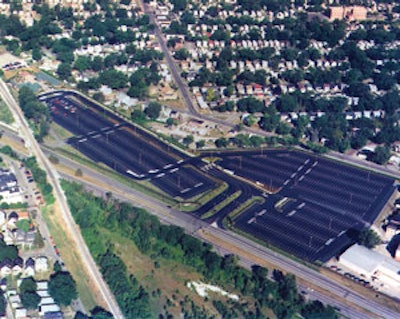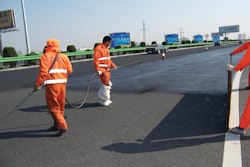
How long will my asphalt last? What can I do to make it last longer? How can I get the most out of my investment in an asphalt pavement?
Those questions and others like them are asked regularly of pavement maintenance contractors throughout the country, and how you answer them can have an impact on your relationship with your client and your reputation in the market.
One of the first things property managers need to understand is that asphalt pavement — like just about everything else — has a finite life. It begins deteriorating almost as soon as it's constructed and while there are steps that can and should be taken to maintain the pavement and extend its life, eventually the asphalt will deteriorate to the point where it will need to be replaced.
But that can be a long-term proposition. Properly constructed and maintained asphalt pavements can easily be expected to last upwards of 15 or 20 years. Poorly constructed or improperly maintained pavements can last as little as half that time.
"There's a lot of controversy over how long asphalt will last," says Charles Bushell, executive director of STAR Inc. "The answer is it depends on a variety of factors, including the traffic, the location, the climate, and a host of other variables. So how long asphalt will last depends on the conditions it's exposed to. While I can't tell you your asphalt pavement will last X amount of years, I can tell you it will last longer if you maintain it properly and use a sealcoat."
But it's not simply the fact of maintenance that affects the life of the pavement, it is the timing of the maintenance as well. Maintenance done at the appropriate time brings the pavement back to its near-new condition, extending its usable life. Maintenance performed after a pavement has deteriorated beyond certain levels cannot bring the pavement back to the optimum performance level.
So timing is everything when performing maintenance, and sealcoating is the first maintenance option that should be done and the maintenance option that should be done most regularly to help extend pavement life.
Take a look at Charts A and B, which show two similar views of what happens to pavement and the costs to maintain it. As Chart A shows, pavement condition deteriorates 40% over 75% of the pavement life. But by 80% of pavement life the pavement experiences another 40% drop in pavement quality. At the same time, maintenance and reconstruction costs are low early in pavement life but rise substantially as the pavement deteriorates. Chart A puts a dollar value on the cost, indicating that $1 spent before the pavement deteriorates significantly will cost $5 after the pavement deteriorates.
Chart B builds on Chart A, showing that maintenance (green lines) done at early and regular intervals actually can bring the pavement back to better condition, thereby extending its useful life, which reduces life cycle costs. But while sealcoating is an integral element of any pavement maintenance effort, it is not enough by itself.
"Ideally, a pavement maintenance program should consist of periodic patching, cracksealing, and sealcoating," says Rich Kish, SealMaster regional manager.
Lee Lowis, vice president, Surface Coatings Co., agrees.
"When done in conjunction with crack repair and pothole repair, sealcoating can be an effective way to protect the pavement and repairs from sun and other damage and can extend the life of the pavement," Lowis says.
STAR Inc.'s "Economics of Sealcoating" chart (page 14) takes the analysis several steps further, comparing suggested maintenance and costs over the life a pavement with costs of a neglected pavement. It becomes clear that property owners who spend maintenance dollars early and regularly in the life of a pavement spend less money overall while extending the life of the pavement — and the life of their investment.
Improves "curb appeal"
Research has shown that the first line of defense is sealcoating, because it protects the asphalt by coating the surface.
"Just as you paint a house to keep the sun and water from ruining the wood, you need to sealcoat a pavement to prevent the sun and water from ruining the pavement," Lowis says.
But when property managers think of sealcoating it is often for the most obvious of reasons: To improve the look of their property. And with good reason.
A spokesperson for the Institute of Real Estate Management (IREM) says the concept of "curb appeal," or how a property looks to the public, is covered in all of IREM's classes, textbooks, and lectures.
"You only get one chance to make a first impression and that first impression is how the property appears from the outside," the spokesperson says. "There's no question that appearance is an important consideration. On a scale of 1 to 10 with 10 being the highest, appearance ranks a 7 or an 8. And the parking lot is a big part of that."
Lowis says that's true particularly for commercial properties, "who are competing with other properties just down the road," and also true for residential homeowners who are proud of the home and want their property to look as good as it can.
"One of the simplest things to do to improve the look of your property is to sealcoat and stripe it," Lowis says. "It simply makes it look a lot better."
Bushell says curb appeal of hotels, for example, helps attract or deter customers.
"People aren't going to stay at a hotel where you have weeds growing up out of the parking lot," Bushell says. "Sealcoating provides the image that the property is well kept, that it's a well-kept hotel."
Edward Kelley, author of Practical Apartment Management, says he thinks the greatest value of sealcoating is in improving curb appeal. He says property aesthetics, and sealcoating in particular, have an impact on occupancy rates and rent.
"People buy with their eyes," Kelley says. "Property managers understand that so it is curb appeal in the manager's mind when considering sealcoating. It's a whole picture and the pavement is only one section, but in any mental photograph of a property the pavement plays an enormous part."
Kelley says he generally recommends sealcoating to property managers. "Not necessarily every year but on an every-other-year basis," he says. "Sealcoating, especially when followed by new bright stripes, gives the property a new look. It shows customers the property managers are caring for the customer and putting money back into the property."
Sealcoating helps pavement
But in addition to making the property look better, sealcoating makes other tangible improvements in pavement.
Seals hairline cracks. Deterioration of asphalt mats often begins with small hairline cracks. These cracks admit water, which weakens the asphalt and eventually creates larger cracks. Sealer fills these hairline cracks and prevents water from making them larger.
Resists oxidation. Exposure to air and the sun's ultra-violet (UV) rays causes the pavement to oxidize. As it dries it becomes brittle, resulting in cracks and other deterioration.
"Sealer prevents the sun from oxidizing the asphalt and drying out the oils that are in the pavement," Lowis says. "UV rays will destroy just about anything over time, and asphalt pavement is no different. Binder, the 'glue' that holds the sand and stone in place, loses strength from sun's rays. UV rays will eventually oxidize the asphalt pavement and will make the mat brittle, eventually allowing the stone and sand to roll out. The mat actually cracks, allowing water to get in, which leads to alligatored areas, potholes, and other defects."
Sealer protects the asphalt mat from the air and slows the oxidation process.
Protects against oil and gas leaks. Oil, gasoline, and other fluid leaking from cars onto parking lot pavement can severely damage the asphalt. Refined coal tar sealer is naturally resistant to these types of materials and asphalt emulsion-based sealer incorporates additives to enhance its resistance.
Regular application of sealer protects parking lots from this damage, which otherwise would result in costly remove-and-replace pavement repairs.
Note: Before sealing over existing oil spots or similar damage those areas must be cleaned and treated with an oil spot primer. Without proper treatment sealer will simply peel off oil spots.
Helps retain flexibility. Asphalt pavement is considered a flexible pavement because of the binder that holds the aggregate together. The oils in the asphalt help keep the pavement flexible, and as the oils dry out the pavement becomes more brittle and loses its flexibility. "Sealer locks in the oils in asphalt and helps retain the properties of the asphalt itself over a period of time," Bushell says.
Replaces eroded surface. As pavement ages, fines on the surface are worn away by rain, traffic, wind, and other factors. The Asphalt Sealcoat Manufacturers Association (ASMA) says application of asphalt emulsion sealer replaces these fine particles.
Eases pavement cleaning. ASMA says that application of a sealcoat results in a smoother surface, which makes it easier to keep the pavement clean by sweeping.
Extends pavement life. Generally, sealer prevents the pavement from breaking down. "Sealcoating increases the longevity of the asphalt when compared to not maintaining it," Bushell says. "Costs are more prohibitive in terms of asphalt maintenance vs. replacement. It protects more cost effectively in the long run."
Saves client money. As the "Economics of Sealcoating" chart shows, use of sealcoating and other pavement maintenance techniques helps extend the life of the existing pavement, making use of sealer a cost-effective approach to pavement maintenance.
"Sealcoat functions as a Saran Wrap over the pavement," Lowis says. "Property managers often have a misconception about that and it's important for contractors to make sure they understand what it does."
Correcting Sealcoating Misconceptions
One of the problems with sealcoating is that while it has been around for more than 50 years some of the available information is inaccurate. Here are some of the things sealcoating doesn't do to an asphalt pavement:
- Sealcoating doesn't rejuvenate pavement. Sealer is merely a protective coating applied to the surface of the pavement. It does not enhance or bring back to life any pavement characteristics.
- Sealer doesn't provide structural improvements. Unlike a patch or an infrared repair, sealcoating does not alter the soundness of the pavement structure in any way.
- Sealcoating is not a pavement repair. Sealcoating is a pavement maintenance approach. It is used on essentially sound pavements to enhance their appearance and slow deterioration.
- Sealcoating doesn't repairs cracks. Cracks in asphalt pavement need to be repaired properly with hot or cold crack repair material. Sealcoating can fill hairline cracks but is not designed for larger cracking.
- Sealcoating doesn't make pavement more pliable. Asphalt is considered a flexible pavement because of the nature of asphalt itself. As it ages it becomes more brittle and subject to cracking. Sealcoating helps the asphalt mat resist this aging process so it retains its flexibility longer.
- All sealers are not alike. There are two primary types of sealer: asphalt emulsion-based sealer and refined coal tar sealer. Both are acceptable products for asphalt pavement (much as latex and oil are acceptable types of paint). Beyond that, manufacturers produce their own specific product that includes a special mix of additives and fillers designed to achieve a desired end result. Some manufacturers also offer two or three lines of sealer themselves, a "good-better-best" option.
- More sealer on the pavement is not necessarily better. Sealer needs to be applied according to manufacturer's recommendations and often that means two (or three) thin coats applied by spray or squeegee. Rich Kish, SealMaster regional manager, says contractors should not try to accomplish in one thick coat what they can accomplish in two thin coats. "Thicker application rates take longer to cure, which may lead to failure," Kish says.



















